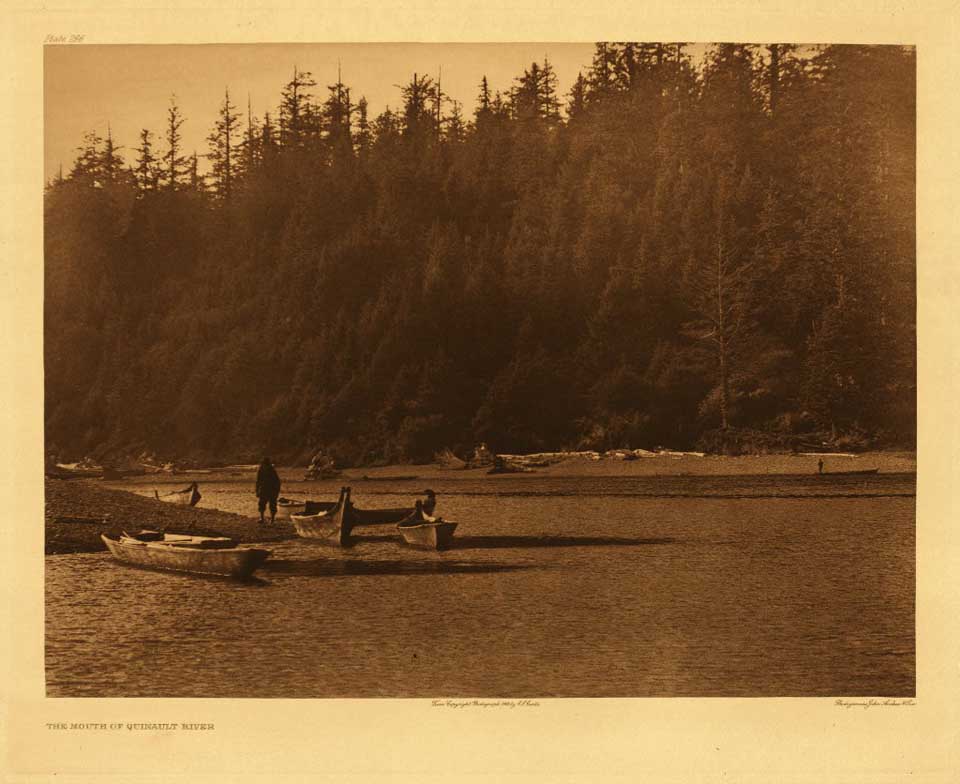The mouth of the Quinault River in c. 1913 (Edward Sheriff Curtis, Northwest University digital collection). Repeat photograph not yet available.
Quadra and the Quinault
In 1775, Spain sent a second expedition of three vessels to the northwest coast from San Blas, Mexico led by Bruno de Heceta. Again, as with the Juan Perez’s 1774, survey, the primary objective was to thwart any Russian advance down the northwest coast by establishing Spanish claim. Leaving one ship to map the San Francisco Bay area, Hecata and Bogeda y Quadra sailed northwards commanding the Santiago and the Sonora. The ships approached the coast near Grenville Point in what is now the state of Washington, likely at the mouth of the Quinault River (shown above). A dory was sent ashore to obtain water, but the crew of seven men were killed or captured by the local Quinaults. As Hecata’s crew was suffering badly from scurvy, he returned south, locating mouth of the Columbia River enroute. But in an amazing voyage, Quadra continued northwards in the Sonora. On August 15 he reached 58 degrees north near the present day location of Sitka, Alaska. The expedition conducted numerous “acts of sovereignty”, traded with native Americans, but saw no sign of the Russians who had not yet established their trading post in the area. 1
The mouth of the Quinault River has long been an important area for human use along this relatively unbroken and exposed stretch of the Pacific coast. Here native peoples followed an annual round of harvesting salmon, shellfish, whales, elk, deer, and numerous plants. Typically, many people believed that landscape effects of coastal peoples may have been very localized, but a combination of traditional knowledge and recent scientific research on the Olympic Penisula is showing the potential broader, regional effects of human use. For centuries, bear grass (Xerophyllum tenax), a tall member of the lily family, has been important for basket weaving. In recent times, bear grass abundance has declined due to increasing forest density and shrinking meadows. Because lightning fires are infrequent here, likely human-burning was important for maintaining bear grass habitat. Justine James, a Quinault natural and cultural resource specialist believes that tribal members may have lit fires along their traditional travel routes over the Olympic Mountains. “They might have burned it as part of their travels, maybe on their return.” If these fires were lit in spring, they could continue to smoulder in pitch-filled stumps and logs until dryer conditions, typical on the Olympic Penisula in mid-summer, occurred. This may have periodically caused some of the large-area fires documented in the area’s history. 2
Also interesting is the idea that traditional horticulturalists may have selectively transplanted and harvested bear grass. The plant is traditionally a subalpine species, found about 15oom elevation, but on the Olympic Penisula, small populations are also found near ancient village sites beside the Pacific Ocean and Puget Sound. Botanist Daniela Shebitz is investigating the biology and genetics of these unique habitats. She remarks that “some of my professors were floored when I sent them a picture of bear grass next to skunk cabbage and camas, typical lowland bog and wetland plants.” 3
< Previous page Fur Trade Chapter Overview Next page>
Map and Footnotes:
- Tovell, Freeman M. (2008). [1. At the Far Reaches of Empire: The Life of Juan Francisco De La Bodega Y Quadra. Vancouver, UBC Press: 25–29. ISBN 978-0-7748-1367-9 ;
http://en.wikipedia.org/wiki/Spanish_expeditions_to_the_Pacific_Northwest ↩
- Shebitz, D. J., S. H. Reichard, and P. W. Dunwiddie. “Ecological and Cultural Significance of Burning Beargrass Habitat on the Olympic Peninsula, Washington.” Ecological Restoration 27: 306-319 (2007) ↩
- http://nwifc.org/2005/03/quinault-indian-nation-working-to-improve-bear-grass-growth/
Accessed 2013/11/07; http://209.206.175.157/documents/CulturalResource.pdf Accessed 2013/11/07 ↩
